The European Union has set carbon neutrality as a priority objective for the year 2050. The high CO2 emissions that we release into the atmosphere every day lead to global warming, creating an increasingly dense gas blanket and also causing the rise of planet Earth’s temperature.
This generates a series of problems such as rising sea levels, alterations in the food chain or extreme increases in temperature. One of the best options to reduce these consequences and achieve decarbonization is through the electrification of the economy.
We are sure you are wondering what this concept is all about, so we will tell you all about it in this article.
What is electrification?
The definition of electrification corresponds to the process of replacing those technologies that use fossil fuels, such as coal, oil or natural gas, with others that run on electricity. We can also define this concept as the way to decarbonize final energy consumption in different sectors, such as transport, construction and industry.
Electrification is at the heart of the path towards energy transition. It is characterized by facilitating the development of renewable energy sources, the evolution of distribution networks and a revolution in using electricity.
Another closely related term is electrification with productive uses, which refers to the use of electricity to provide services that previously relied on other energy sources, such as fossil fuels. Electric cars as well as buses are examples of electrification with productive uses.
Another example is the electrification of energy use in buildings: a sector in which the share of electricity in final energy demand will grow from 42% in 2030 to 72% by 2050 thanks to the use of heat pumps and other improvements. Driving the progressive electrification of our buildings helps to replace the fossil fuels needed for heating and cooling systems.
Main sectors to be electrified
As we have already mentioned, electricity obtained from renewable sources can replace the direct use of fossil fuels. This is even more necessary in the sectors causing greenhouse gas emissions. These include:
- Transportation: the car is the vehicle emitting the greatest amount of CO2 per passenger, while electric vehicles are between three and five times more efficient than those with internal combustion engines. This is why it is expected that by 2030 around five million of these types of cars will be on the Spanish roads.
- Buildings: more than 8,000,000 homes have been built in the last three decades in Spain, adding to this number all the public buildings and old constructions, we obtain an immense amount of buildings in need of electricity. For this reason, reduction strategies, such as, the exchange of oil or gas boilers for heat pumps that reduce the energy used by up to four times are necessary.
- Industry: if its production processes are electrified, the energy intensity used decreases significantly, which is one of the objectives to be achieved with the digital transformation of Industry 4.0.
What are the benefits of electrification?
The main objective of electrification is to reduce emissions of polluting gases into the atmosphere, but it is not the only one, since this process brings other benefits with it. We will tell you about them:
- Energy independence: the abandonment of fossil fuels and the increased use of electricity means less dependence on third parties to supply us with these fuels.
- Job creation: The National Integrated Energy and Climate Plan (PNIEC) 2021-2030 forecasts that investment in renewable energy could generate between 107,000 and 135,000 jobs by 2030. In addition, according to forecasts, the change in the energy model could create close to 120,000 indirect jobs annually.
- Less energy depletion: not only are fossil fuels highly harmful, but they also cause other problems such as difficulties of supply or resource depletion. As we already know, fossil energy has an established end, since it is extracted and consumed. This is not the case with electricity – natural resources are only means to obtain the final energy but they cannot be depleted.
- Achieving smart homes and offices: electronic devices are increasingly connected thanks to the opportunities of new technologies, which allows the digitization of homes and buildings, paving the way for Smart Homes and Smart Buildings, the new real estate of smart cities. This digitization not only brings greater flexibility and convenience, but also helps us to improve efficiency and reduce time and costs.
- Savings on our bills: another of the major advantages of renewables is their cost-effectiveness, being the cheapest possible source of electricity. With the increase in power generation from renewables, the average cost on the bill that consumers pay will decrease.
The importance of electrification
Electricity produced from renewable energy sources is currently the most efficient and cost-effective solution for achieving greenhouse gas emission reductions.
In addition to promoting electricity production based on the RES, decarbonization requires the electrification of energy demand, i.e. that households and businesses make greater use of electricity instead of using CO2-emitting technologies.
Electricity is therefore the key energy vector to combat climate change and protect the environment.
That is why LRP Energy wants to join this fight and offer the best solutions for photovoltaic self-consumption, with terms that guarantee the minimum payback period and bill savings between 50% and 70%.
Do not hesitate and ask for your free study to know the feasibility of solar energy in your home.

